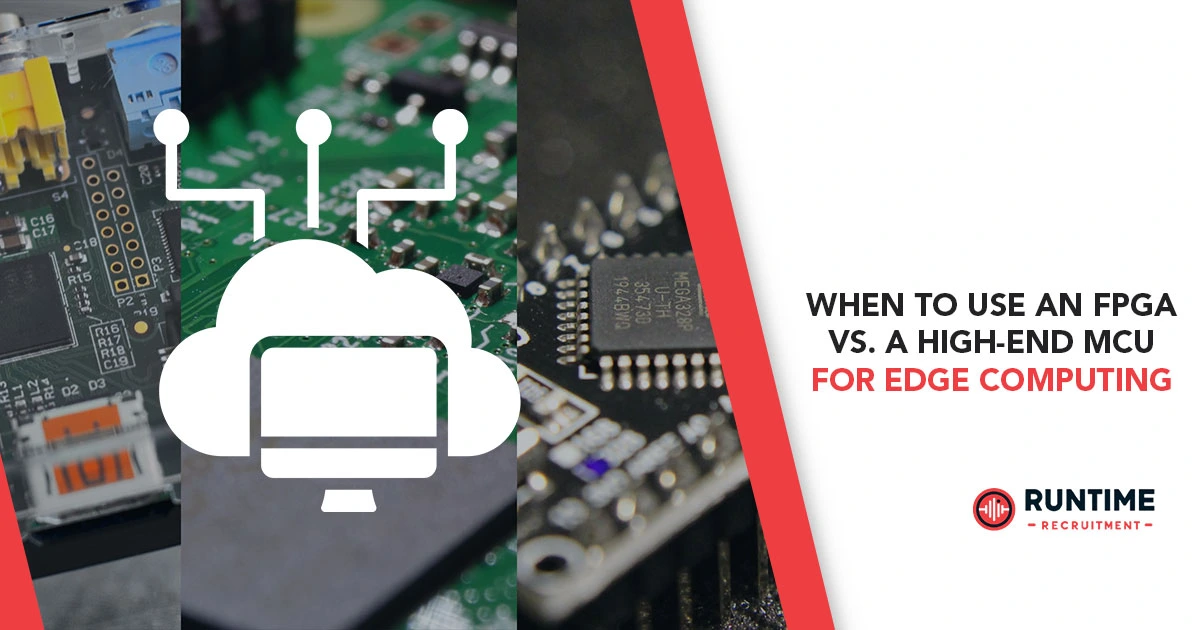The burgeoning field of edge computing, driven by the proliferation of IoT devices and the demand for real-time data processing, presents embedded engineers with critical architectural choices. At the heart of many edge deployments lies a fundamental decision: to leverage the parallel processing prowess of a Field-Programmable Gate Array (FPGA) or the versatile, software-driven capabilities of a high-end Microcontroller Unit (MCU). Both offer distinct advantages and disadvantages, and a judicious selection is paramount for optimizing performance, power consumption, cost, and development effort.
This article will provide an in-depth comparison, guiding embedded engineers in making informed decisions for their specific edge computing applications.
Understanding the Core Architectures
Before delving into the comparative analysis, it’s essential to grasp the fundamental architectural differences that define FPGAs and MCUs.
Field-Programmable Gate Arrays (FPGAs): Reconfigurable Hardware at Your Fingertips
FPGAs are integrated circuits designed to be configured by the customer or designer after manufacturing. Unlike fixed-architecture processors, FPGAs consist of a vast array of programmable logic blocks (PLBs or CLBs) and a hierarchy of reconfigurable interconnects. These elements can be “wired” together using a hardware description language (HDL) like VHDL or Verilog, allowing engineers to create custom digital circuits.
The key strength of an FPGA lies in its true hardware parallelism. Each independent task can be assigned to a dedicated section of the chip and function autonomously, without competing for shared resources. This allows for highly optimized, low-latency processing of multiple operations simultaneously. FPGAs often include specialized components such as Digital Signal Processing (DSP) slices for efficient arithmetic operations, and Block RAM (BRAM) for on-chip memory.
High-End Microcontroller Units (MCUs): Software-Driven Intelligence on a Chip
A high-end MCU, in contrast, is a compact integrated circuit that houses a CPU core (often an ARM Cortex-M or a powerful RISC-V core), memory (Flash for program storage, SRAM for data), and a rich set of integrated peripherals (timers, ADCs, DACs, communication interfaces like UART, SPI, I2C, USB, Ethernet, CAN, etc.) on a single chip.
MCUs operate by executing software instructions sequentially. While modern high-end MCUs often feature multiple CPU cores, advanced pipelining, and specialized accelerators (e.g., for DSP or even basic AI inference), their fundamental mode of operation is sequential instruction processing. Their strength lies in their ease of programming using high-level languages like C or C++, readily available development tools, and a mature ecosystem.
Key Considerations for Edge Computing
The choice between an FPGA and a high-end MCU for an edge computing application hinges on several critical factors:
1. Performance and Throughput
- FPGAs: When raw parallel processing power and deterministic, low-latency execution are paramount, FPGAs often reign supreme. Their ability to implement custom data paths and parallelize operations at the hardware level allows them to achieve exceptionally high throughput for specific tasks. This makes them ideal for applications involving high-speed data acquisition, real-time signal processing (e.g., filtering, FFTs), custom protocol acceleration, or complex image and video processing pipelines. For instance, in real-time machine vision, an FPGA can process multiple video streams concurrently with minimal latency, a feat that would overwhelm even the most powerful MCUs.
- High-End MCUs: High-end MCUs offer significant processing power for general-purpose computing tasks. Their multi-core architectures and increasingly fast clock speeds can handle complex algorithms and manage multiple software threads. For applications where data processing can be largely sequential or where the computational load is moderate, an MCU can provide ample performance. Modern high-end MCUs are also integrating dedicated hardware accelerators for tasks like AI inference (e.g., neural network accelerators), making them increasingly capable for certain edge AI workloads, though often with less flexibility than an FPGA’s customizability.
2. Power Consumption
- FPGAs: Historically, FPGAs have been associated with higher power consumption due to their reconfigurable fabric and the need to power many configurable logic blocks. However, advancements in process technology and power management techniques have significantly improved their power efficiency. For highly optimized, custom designs where only necessary logic is instantiated and unused sections can enter sleep mode, FPGAs can be remarkably power-efficient for specific workloads. Nevertheless, for general-purpose processing or less optimized designs, they still tend to consume more power than an equivalent MCU solution.
- High-End MCUs: MCUs are inherently optimized for low-power operation, a critical factor for many battery-powered or energy-constrained edge devices. They feature sophisticated power-saving modes (sleep, deep sleep, idle) and power gating capabilities that allow unused peripherals and CPU cores to be shut down. For applications demanding long battery life and minimal power draw, high-end MCUs typically offer a more attractive solution.
3. Cost (Initial and Long-Term)
- FPGAs: The initial cost of FPGAs themselves, especially higher-end devices with significant logic resources, can be substantially greater than high-end MCUs. Furthermore, the development ecosystem for FPGAs, including specialized EDA tools and development boards, can also be more expensive. However, for high-volume production, if an FPGA can replace multiple discrete components or enable a unique, high-value feature, the total system cost might become competitive. The ability to update functionality in the field without hardware redesign can also lead to long-term cost savings.
- High-End MCUs: MCUs are generally more cost-effective, particularly for moderate to high-volume applications. The development tools are often free or inexpensive, and the mature ecosystem means a wider availability of readily integrated components and lower overall bill-of-materials (BOM) for many designs. For applications that can be adequately addressed by a standard MCU, they represent the more economically sensible choice.
4. Development Time and Complexity
- FPGAs: Developing with FPGAs involves a steep learning curve and a different paradigm compared to software development. Engineers need proficiency in hardware description languages (HDLs), digital design principles, synthesis, place-and-route, and timing analysis. The iterative design cycle of FPGA development (simulation, synthesis, implementation, programming, testing) can be considerably longer than software development on an MCU, especially for complex designs. However, for rapid prototyping of custom hardware accelerators or novel architectures, FPGAs can significantly reduce the time to market compared to a full ASIC design.
- High-End MCUs: MCUs benefit from a well-established and mature software development ecosystem. Programming is typically done in C/C++ or Python, leveraging familiar integrated development environments (IDEs), compilers, and debugging tools. The abundance of libraries, drivers, and community support significantly accelerates development time for many applications. Even with complex multi-threaded applications on high-end MCUs, the software-centric approach generally leads to faster iteration and deployment.
5. Flexibility and Reconfigurability
- FPGAs: This is where FPGAs truly shine. Their ability to be reconfigured after manufacturing provides unparalleled flexibility. Functionality can be updated, new features added, or even entirely different applications deployed to the same hardware in the field. This “future-proofing” is invaluable for evolving standards, new algorithms (especially in AI/ML), or adapting to changing operational requirements at the edge. Partial reconfiguration allows specific parts of the FPGA to be updated while the rest of the system remains operational, minimizing downtime.
- High-End MCUs: MCU flexibility is primarily software-based. While firmware updates can add new features or fix bugs, the underlying hardware architecture remains fixed. Any major change requiring different peripheral configurations or fundamentally different processing approaches might necessitate a hardware redesign or a new MCU. While some MCUs offer a degree of pin multiplexing or configurable peripheral blocks, it pales in comparison to the hardware reconfigurability of an FPGA.
6. Security
- FPGAs: FPGAs offer unique security advantages due to their hardware-level programmability. Critical functions can be implemented directly in hardware, making them less susceptible to software-based attacks. Secure boot, hardware root of trust, and advanced cryptographic accelerators can be designed directly into the FPGA fabric, offering robust protection. However, the complexity of FPGA design can also introduce vulnerabilities if not implemented carefully, and securing the bitstream itself is a crucial consideration.
- High-End MCUs: Modern high-end MCUs are increasingly incorporating hardware security features such as secure boot, cryptographic engines, true random number generators (TRNGs), and isolated execution environments (e.g., ARM TrustZone). While these provide a strong foundation for security, the inherent software-driven nature means they are still potentially more vulnerable to software exploits compared to purely hardware-implemented functions on an FPGA. Security patches and updates are vital for MCU-based systems.
7. Ecosystem and Tooling
- FPGAs: The FPGA ecosystem is specialized and requires vendor-specific tools (e.g., Xilinx Vivado, Intel Quartus Prime). While these tools are powerful, they have a steeper learning curve and can be resource-intensive. High-level synthesis (HLS) tools are emerging to allow C/C++ code to be translated into hardware designs, bridging the gap for software engineers, but they are still maturing and may not always yield optimal hardware.
- High-End MCUs: The MCU ecosystem is vast and well-established, with numerous vendors, open-source projects, and a large community. Standardized toolchains (e.g., GNU Arm Embedded Toolchain) and widely supported IDEs (e.g., Keil MDK, IAR Embedded Workbench, VS Code with extensions) make development accessible and efficient. The availability of real-time operating systems (RTOS) further simplifies complex multi-tasking applications.
Applications in Edge Computing: Where Each Excels
When to Lean Towards FPGAs:
- Real-time Sensor Fusion and Data Pre-processing: Applications requiring very high-speed, parallel processing of raw sensor data (e.g., LiDAR, radar, high-resolution cameras) before feeding it to an AI inference engine. FPGAs can perform filtering, noise reduction, data compression, and feature extraction at line rates.
- Custom Communication Protocols: Implementing non-standard or highly specialized communication interfaces that require precise timing and high throughput, often seen in industrial automation or niche networking.
- Hardware Acceleration for AI/ML Inference: While GPUs are dominant in cloud AI training, FPGAs offer compelling advantages for edge inference, especially when custom neural network architectures or highly optimized fixed-point arithmetic are required for power and latency efficiency. They excel at highly parallel, repetitive computations like convolutions.
- Deterministic Control Systems: Applications demanding extremely precise and predictable timing for critical control loops, such as advanced robotics, motor control, or industrial machinery, where even microsecond delays can be detrimental.
- Image and Video Processing: High-resolution video encoding/decoding, real-time video analytics, or complex image manipulation at the source, where massive parallelism is beneficial.
- High-Bandwidth Data Acquisition: Systems that need to capture and process large volumes of data from multiple high-speed ADCs or digital interfaces simultaneously.
Real-world FPGA Edge Computing Examples:
- Advanced Driver-Assistance Systems (ADAS): FPGAs are used for real-time processing of camera, radar, and LiDAR data for object detection, lane keeping, and collision avoidance. For instance, an AMD Xilinx FPGA AI Customer Platform has been used for pavement defect detection in ADAS, integrating a Deep Learning Processing Unit (DPU) to execute YOLOv3 models efficiently.
- Industrial Machine Vision: High-speed inspection systems on factory floors using FPGAs to analyze images for defects in real-time.
- 5G Base Stations at the Edge: FPGAs accelerate the physical layer processing of 5G signals, enabling high bandwidth and low latency communication.
- Medical Imaging Devices: Processing of high-resolution sensor data in portable medical devices for real-time diagnosis.
When to Lean Towards High-End MCUs:
- General-Purpose Edge Gateways/Controllers: When the primary role is data aggregation, protocol translation, local data storage, and sending processed data to the cloud, a high-end MCU with ample connectivity (Ethernet, Wi-Fi, cellular) and processing power for light analytics is often sufficient.
- Battery-Powered IoT Devices: Sensors, wearables, smart home devices, and other applications where ultra-low power consumption and long battery life are paramount.
- Human-Machine Interfaces (HMIs) and User Interfaces (UIs): Driving displays, processing touch inputs, and managing user interactions that don’t require extreme computational horsepower.
- Distributed Control Systems with Moderate Timing Requirements: Applications where real-time responses are needed but can tolerate millisecond-level latencies, such as building automation, smart lighting, or agricultural monitoring.
- Simple AI/ML Inference with Pre-trained Models: Many high-end MCUs now include specialized DSP or neural network acceleration units, making them capable of running small to medium-sized pre-trained inference models efficiently for tasks like keyword spotting or basic object recognition.
- Cost-Sensitive and High-Volume Applications: When the per-unit cost is a major driver, and the performance requirements can be met by an MCU, it’s typically the more economical choice.
Real-world High-End MCU Edge Computing Examples:
- Smart Appliances: Refrigerators, washing machines, and ovens with connectivity and some level of local intelligence for diagnostics or control.
- Industrial Sensors and Actuators: Devices collecting environmental data, controlling motors, or managing simple processes on a factory floor.
- Medical Wearables: Fitness trackers, continuous glucose monitors, or basic health monitoring devices.
- Robotics (Smaller Scale): Control of individual joints, basic navigation, or sensor processing in smaller, less computationally intensive robots.
- Smart Agriculture: Monitoring soil conditions, controlling irrigation systems, or managing livestock trackers.
Hybrid Approaches: The Best of Both Worlds
It’s increasingly common to see hybrid architectures emerge at the edge, leveraging the strengths of both FPGAs and high-end MCUs. System-on-Programmable-Chips (SoPCs), often marketed as System-on-Chips (SoCs) with integrated FPGAs, feature hard-processor systems (HPS) – typically ARM Cortex-A series processors – alongside programmable logic. This allows the MCU portion to handle general-purpose tasks, operating systems (Linux), networking, and file systems, while the FPGA fabric is dedicated to accelerating specific, performance-critical workloads.
For example, an SoPC could have the ARM core manage the overall system, handle network communication, and run a lightweight operating system, while the integrated FPGA is tasked with real-time video processing, custom sensor interface logic, or a highly optimized neural network inference engine. This approach offers a powerful combination of flexibility, performance, and ease of software development.
Conclusion
The decision between an FPGA and a high-end MCU for edge computing is not a one-size-fits-all answer. It’s a nuanced engineering trade-off that requires a thorough understanding of the application’s specific requirements. Embedded engineers must carefully weigh performance, power consumption, cost, development time, security needs, and future flexibility.
For applications demanding ultimate parallelism, deterministic low-latency, and custom hardware acceleration, particularly in rapidly evolving fields like AI/ML at the edge, FPGAs offer unmatched capabilities. However, they come with a higher barrier to entry in terms of development complexity and often initial cost.
Conversely, for the vast majority of edge computing applications that benefit from a mature software ecosystem, lower power consumption, and a more straightforward development cycle, high-end MCUs provide a compelling and cost-effective solution. Their increasing integration of specialized accelerators further extends their reach into traditionally FPGA-dominated areas.
Ultimately, the most effective edge computing solutions may often employ a synergistic approach, combining the software-driven versatility of a high-end MCU with the hardware-accelerated power of an FPGA, especially through SoPC designs. By carefully considering the unique demands of each project, embedded engineers can architect robust, efficient, and future-proof edge computing systems.









